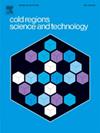Study on the influence of early frost attack on the performance of cement mortar
IF 3.8
2区 工程技术
Q1 ENGINEERING, CIVIL
引用次数: 0
Abstract
The loss of strength and durability caused by early frost attack is the macro performance of internal microstructure deterioration. Understanding the influence mechanism of early frost attack at the micro level is necessary to avoid or minimize the early frost attack to macro performance. In this study, the influence of early frost attack on the strength, water sorptivity, chloride permeability, and microstructure of cement mortar was investigated. The fresh mortars were pre-cured for 10, 12, 14, and 16 h and then frozen at −10 °C for 7 days to simulate an early frost attack. After freezing, the standard curing (20 °C) was carried out until the testing. It is found that after standard curing of 28 days, the strength of early-frozen mortar can reach more than 95 % of the 28-day strength of unfrozen mortar. Interestingly, the sorptivity coefficient and total charge passed of early-frozen mortar are much higher than the level of unfrozen mortar, and the loss of resistance to water penetration and chloride ion penetration exceeds 20 %, indicating that early frost attack causes more severe damage to the durability than to the strength of mortar. Mercury intrusion porosimetry (MIP) results show that early frost attack can increase the pore volume of >50 nm and coarsen the pores within 10–50 nm. Correspondingly, key pore parameters (critical pore diameter, threshold pore diameter, and tortuosity) that affect the durability of mortar are also negatively affected. Energy dispersive spectroscopy (EDS) analysis also shows that after suffering early frost attack, the interfacial transition zone (ITZ) thickness of mortar is increased from 4 to 10 μm to 8–13 μm, and the probability of high Ca/Si ratios (4–10) in the ITZ is also increased. Finally, it is concluded that the coupling effect of pore structure coarsening and ITZ degradation leads to more severe durability loss.
研究早期冻害对水泥砂浆性能的影响
早期冻害造成的强度和耐久性损失是内部微结构劣化的宏观表现。要避免或减少早期冻害对宏观性能的影响,就必须了解早期冻害在微观层面的影响机理。本研究调查了早霜对水泥砂浆强度、吸水率、氯离子渗透率和微观结构的影响。将新拌砂浆分别预养护 10、12、14 和 16 小时,然后在 -10 °C 下冷冻 7 天,以模拟早期冻害。冷冻后,进行标准养护(20 °C)直至测试。结果发现,在标准养护 28 天后,早冻砂浆的强度可达到未冻砂浆 28 天强度的 95% 以上。有趣的是,早冻砂浆的吸水系数和总电荷通过量远高于未冻砂浆的水平,抗水渗透和抗氯离子渗透的损失超过 20%,这表明早冻对砂浆耐久性的破坏比对砂浆强度的破坏更为严重。水银渗入孔隙模拟(MIP)结果表明,早期冻害可使孔隙体积增大 50 nm,并使 10-50 nm 范围内的孔隙变粗。相应地,影响砂浆耐久性的关键孔隙参数(临界孔隙直径、阈值孔隙直径和扭曲度)也会受到负面影响。能量色散光谱(EDS)分析还显示,在遭受早期霜冻侵蚀后,砂浆的界面过渡区(ITZ)厚度从 4 至 10 μm 增加到 8 至 13 μm,ITZ 中高 Ca/Si 比率(4-10)的概率也增加了。最后得出的结论是,孔隙结构粗化和 ITZ 退化的耦合效应导致了更严重的耐久性损失。
本文章由计算机程序翻译,如有差异,请以英文原文为准。
求助全文
约1分钟内获得全文
求助全文
来源期刊

Cold Regions Science and Technology
工程技术-地球科学综合
CiteScore
7.40
自引率
12.20%
发文量
209
审稿时长
4.9 months
期刊介绍:
Cold Regions Science and Technology is an international journal dealing with the science and technical problems of cold environments in both the polar regions and more temperate locations. It includes fundamental aspects of cryospheric sciences which have applications for cold regions problems as well as engineering topics which relate to the cryosphere.
Emphasis is given to applied science with broad coverage of the physical and mechanical aspects of ice (including glaciers and sea ice), snow and snow avalanches, ice-water systems, ice-bonded soils and permafrost.
Relevant aspects of Earth science, materials science, offshore and river ice engineering are also of primary interest. These include icing of ships and structures as well as trafficability in cold environments. Technological advances for cold regions in research, development, and engineering practice are relevant to the journal. Theoretical papers must include a detailed discussion of the potential application of the theory to address cold regions problems. The journal serves a wide range of specialists, providing a medium for interdisciplinary communication and a convenient source of reference.
 求助内容:
求助内容: 应助结果提醒方式:
应助结果提醒方式:


